In 1612, a young girl is raped and returns home in distress. Trying to protect her family’s honor, she finds and uses a dagger but ends up feeling overwhelmed with guilt. This tragedy is depicted in Rembrandt’s painting, where a girl with a knife in her abdomen stains her previously clean clothes with blood while her family rushes down the stairs too late to help. The girl ultimately loses her life.
The painting reflects on the profound emotional impact one would experience upon discovering that their own daughter had been raped and committed suicide; it elicits an indescribable anguish.
Rembrandt’s exceptional artistic ability allowed him to capture intricate emotions on canvas, accurately portraying a range of feelings such as guilt, anger, sadness, frustration, and more. On my visit to the Rembrandt exhibit at the North Carolina Art Museum in Raleigh last winter, I had the opportunity to witness an extensive collection of Rembrandt paintings presented in an American exhibition for the first time. Among the notable artworks displayed was “The Suicide of Lucretia,” which vividly depicts this tragic event – showcasing the downfall of a young girl whose untimely death sparked a revolution resulting in the overthrow of monarchy and establishment of Rome’s Republic.
Rembrandt’s talent is evident in his representation of Lucretia, as he skillfully captures both her emotional state and conveys her family’s honor, virtue, and duty through the expression in her eyes. The painting not only depicts the intensity of the moment but also narrates the impact of this young woman on society. These factors establish Rembrandt as a renowned Dutch Realist artist. This historical piece of art exudes tremendous power and emotion.
In my younger years, there existed an art museum in Fayetteville where my brother participated in one of their summer art enrichment camps. On a particular occasion, my mother and I were waiting to pick up my brother, Alex.
While waiting, we took a quick tour of the museum and came across a quote on a wall: “A picture is worth a thousand words.” At that moment, I didn’t completely grasp its significance, so I turned to my mom for clarification. She explained that it was actually a cliché and proceeded to define what exactly a cliché entails. According to her explanation, this specific cliché conveys the idea that an image has the power to effectively narrate a story just like words can. To illustrate her point further, she drew parallels between it and the cover page of a book—a glimpse into what lies ahead in the narrative.
A picture speaks volumes. When I visited the museum, it not only deepened my appreciation for art and expanded my knowledge, but also enhanced my admiration for my mother. The saying holds true: a lone image can encapsulate a moment, narrate a tale, or unveil sincere emotion. Throughout time, celebrated artists such as Van Gogh with his renowned masterpiece “Starry Night” and Monet with his iconic painting “Impression Sunrise” have produced artworks that surpassed verbal expression.
Leonardo Davinci is famous for his painting, the “Mona Lisa”. In 1962, the painting was insured for $100 million dollars, which in today’s terms would be equivalent to $645 million. The incredible value of the painting leaves me speechless and reinforces the saying that a picture is worth a thousand words. To truly understand the significance of this cliché, we must assess the worth of a thousand words. What kind of words would they be? Random words, biblical verses, or perhaps words from a famous speech? One example of a thousand-word speech is Martin Luther King Junior’s iconic “I Have a Dream” speech.
The importance of this speech in the Civil Rights movement cannot be overstated, yet it can be purchased online for around $8. If we consider that a mere thousand words are worth only $8, then both the Mona Lisa and Rembrandt’s masterpiece far surpass their value. I strongly believe that a picture possesses the worth of a thousand words and that its significance lies in the narrative it tells and the emotions it elicits. This cliché effectively demonstrates how artworks can be priceless. Whether a picture costs $20 at your local art store or is insured for $100 million, it has the ability to convey a story valued at a thousand words.
This cliche is based on a misinterpreted translation of an original Chinese proverb that actually says a picture can convey the meaning of ten thousand words. In my opinion, a picture surpasses mere words in its ability to express emotions. Take for example the painting “The Scream,” which effectively conveys fear in a way that the word “fear” alone cannot capture accurately. Describing this singular emotion would require many words, while one painting effortlessly captures and expresses it. Conversely, Rembrandt’s artwork portrays multiple emotions.
The power of pictures is often underestimated. Paintings can effectively convey emotions and narratives, surpassing even the most skilled writers. While it’s commonly said not to judge a book by its cover, sometimes the cover captures the essence of a story better than the book itself. Although there’s a debate about books being superior to movies, reading takes days while watching a movie only requires hours. However, it’s important to note that movies still rely on words to some extent. To fully comprehend the storytelling potential of pictures, we can examine silent films like The Three Stooges who entertain and tell comedic stories without utilizing any words.
Pictures are a more efficient way to convey a story, affirming the timeless cliche that a picture is worth a thousand words. I believe this to be true, accurate, and insightful. Pictures can depict emotions, convey words, and narrate stories. While authors may need several chapters to establish a setting, a painting’s setting is inherently present all around it, seamlessly integrated into the artwork itself. This integration makes the setting an integral part of the painting—a concise and profound form of expression surpassing any written collection of words. Undoubtedly, pictures hold immeasurable value.





